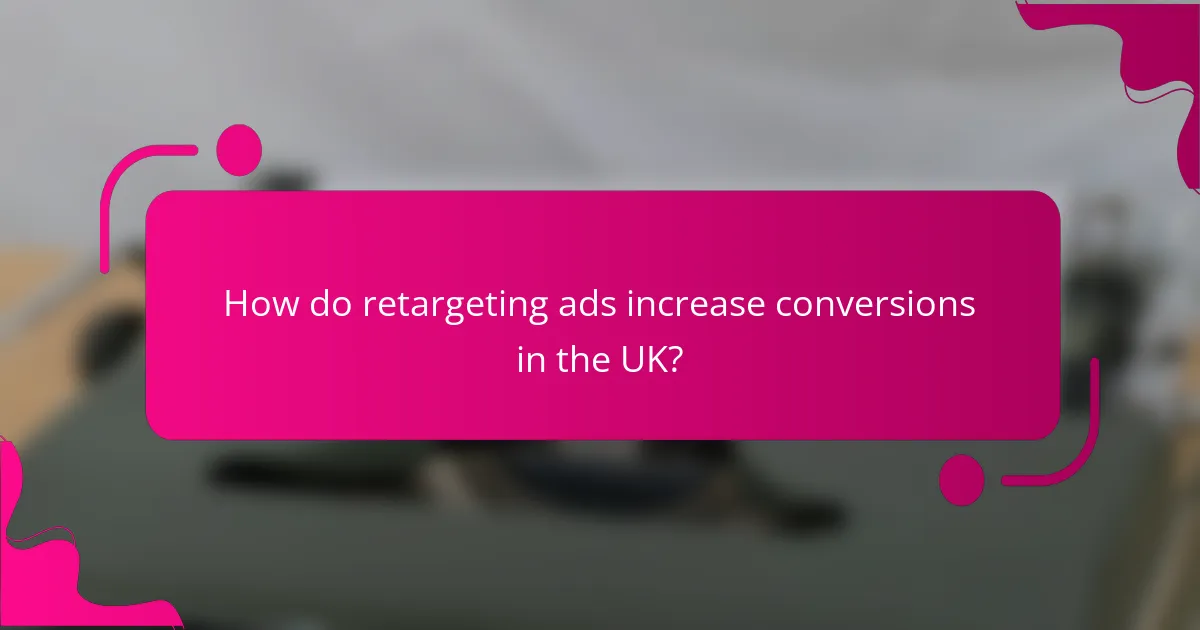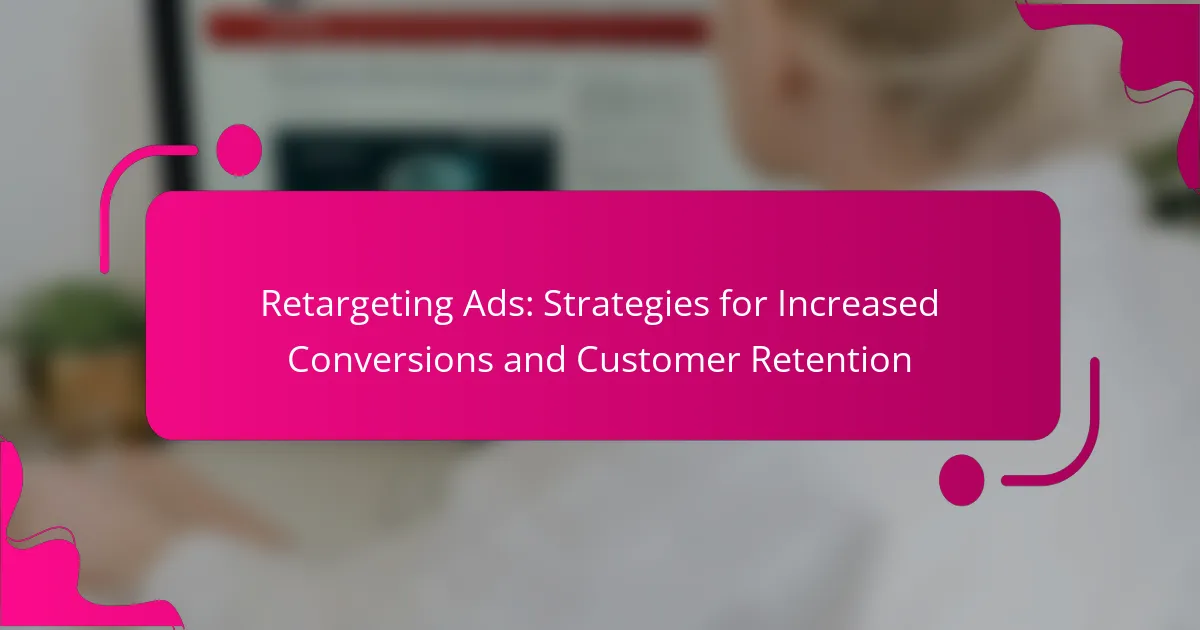Retargeting ads are a powerful tool for increasing conversions and customer retention by reminding potential customers of products they have previously shown interest in. By leveraging user behavior data and employing personalized strategies such as dynamic product ads and abandoned cart reminders, businesses can effectively re-engage users and drive sales. Measuring the success of these campaigns through key performance indicators ensures that companies can refine their approach for optimal results.

How do retargeting ads increase conversions in the UK?
Retargeting ads boost conversions in the UK by reminding potential customers of products they previously viewed, encouraging them to complete their purchases. This strategy leverages user behavior data to deliver relevant ads, enhancing the likelihood of engagement and sales.
Personalized ad experiences
Personalized ad experiences are crucial for effective retargeting. By displaying ads tailored to individual interests and previous interactions, brands can create a more engaging shopping experience. For instance, if a user browsed running shoes, showing them ads featuring those specific models can significantly increase the chances of conversion.
To implement personalized ads, utilize data analytics tools to track user behavior and preferences. This allows for the creation of dynamic ads that reflect the user’s interests, making them feel more relevant and timely.
Increased brand recall
Retargeting ads enhance brand recall by keeping a brand top-of-mind for potential customers. When users see familiar products or brands repeatedly, they are more likely to remember them when making purchasing decisions. This is particularly effective in competitive markets where numerous options exist.
Consider using frequency caps to avoid overwhelming users with too many ads, which can lead to ad fatigue. A balanced approach ensures that the brand remains memorable without becoming intrusive.
Targeted audience segmentation
Targeted audience segmentation allows brands to focus their retargeting efforts on specific groups based on demographics, interests, and behaviors. This strategy ensures that ads reach the most relevant audiences, increasing the likelihood of conversions. For example, segmenting users who abandoned their carts versus those who simply browsed can lead to different ad strategies.
Utilize tools like Google Ads or Facebook Ads Manager to create audience segments based on user data. Regularly analyze the performance of these segments to refine targeting and improve overall campaign effectiveness.

What are effective retargeting strategies for UK businesses?
Effective retargeting strategies for UK businesses focus on personalized ads that engage users who have previously interacted with their brand. By utilizing techniques such as dynamic product ads, sequential retargeting, and abandoned cart reminders, businesses can significantly enhance conversions and improve customer retention.
Dynamic product ads
Dynamic product ads automatically show users the specific products they viewed on a website, tailored to their interests. This personalization increases the likelihood of conversions as it reminds users of their previous interactions and encourages them to revisit the site.
To implement dynamic product ads, businesses should integrate their product catalog with advertising platforms like Facebook or Google Ads. Ensure that the product feed is regularly updated to reflect current inventory and pricing, which is crucial for maintaining relevance and accuracy.
Sequential retargeting
Sequential retargeting involves displaying ads in a specific order based on the user’s previous interactions. This strategy guides potential customers through a narrative or sales funnel, gradually increasing their engagement and interest in the brand.
For effective sequential retargeting, create a series of ads that highlight different aspects of your products or services. For example, start with brand awareness ads, followed by product benefits, and finally, a limited-time offer. This method keeps the audience engaged and encourages them to take action.
Abandoned cart reminders
Abandoned cart reminders target users who added items to their cart but did not complete the purchase. These reminders can be sent via email or displayed as ads, prompting users to finalize their transactions.
To maximize effectiveness, send reminders within a few hours of abandonment, ideally including images of the abandoned products and a clear call to action. Offering a small discount or free shipping can also incentivize users to complete their purchase, making this a powerful strategy for boosting conversions.

How can businesses measure the success of retargeting ads?
Businesses can measure the success of retargeting ads through various metrics that reflect user engagement and conversion effectiveness. Key performance indicators (KPIs) such as conversion tracking metrics, return on ad spend (ROAS), and click-through rates (CTR) provide insights into how well retargeting efforts are performing.
Conversion tracking metrics
Conversion tracking metrics are essential for understanding the effectiveness of retargeting ads. These metrics typically include the number of conversions, conversion rate, and cost per conversion. By analyzing these figures, businesses can determine which ads are driving sales and optimize their campaigns accordingly.
To implement conversion tracking, businesses should set up tracking pixels or tags on their websites. This allows them to monitor user actions, such as purchases or sign-ups, after interacting with retargeting ads. Regularly reviewing these metrics helps identify trends and areas for improvement.
Return on ad spend (ROAS)
Return on ad spend (ROAS) measures the revenue generated for every dollar spent on advertising. A higher ROAS indicates a more effective retargeting campaign. Businesses should aim for a ROAS of at least 4:1, meaning they earn four dollars for every dollar spent, although this can vary by industry.
To calculate ROAS, divide the total revenue generated from retargeting ads by the total ad spend. Monitoring this metric helps businesses assess the profitability of their campaigns and make informed decisions about budget allocation and strategy adjustments.
Click-through rates (CTR)
Click-through rates (CTR) indicate the percentage of users who click on a retargeting ad after seeing it. A higher CTR suggests that the ad is relevant and engaging to the target audience. Businesses should strive for a CTR of around 1% to 3%, depending on the industry and ad format.
To improve CTR, businesses can experiment with different ad creatives, messaging, and targeting options. A/B testing various elements can help identify what resonates best with the audience, ultimately leading to higher engagement and conversion rates.

What tools can enhance retargeting ad campaigns?
Several tools can significantly improve the effectiveness of retargeting ad campaigns by providing advanced targeting options, analytics, and automation features. Utilizing these tools can help marketers optimize their strategies for better conversions and customer retention.
Google Ads
Google Ads offers robust retargeting capabilities through its Display Network and Search Ads. Advertisers can create custom audiences based on user behavior, such as website visits or specific actions taken, allowing for personalized ad experiences.
To maximize effectiveness, consider segmenting your audience into different categories, such as cart abandoners or previous purchasers. This allows for tailored messaging that resonates with each group, improving engagement rates.
Facebook Ads Manager
Facebook Ads Manager provides powerful retargeting options through Custom Audiences and Lookalike Audiences. You can retarget users who have interacted with your Facebook page, visited your website, or engaged with your content, ensuring your ads reach the right audience.
Utilize dynamic ads to showcase products that users have previously viewed, which can significantly increase conversion rates. Regularly monitor performance metrics to adjust your campaigns based on user engagement and behavior.
AdRoll
AdRoll specializes in retargeting across multiple platforms, including social media and email. It offers a comprehensive suite of tools to track user behavior and serve ads based on their interactions with your brand.
Consider using AdRoll’s predictive analytics to identify potential high-value customers and tailor your campaigns accordingly. This platform also supports cross-device retargeting, ensuring your ads reach users wherever they are active.

What are common mistakes to avoid in retargeting?
Common mistakes in retargeting can significantly reduce the effectiveness of your campaigns. Avoiding these pitfalls can enhance conversion rates and improve customer retention.
Overexposure to ads
Overexposure occurs when users see the same ad too frequently, leading to ad fatigue and negative brand perception. This can result in users ignoring your ads or even developing a dislike for your brand.
To prevent overexposure, limit the number of times a user sees your ad within a specific timeframe. A good practice is to aim for a frequency cap of around 3-5 impressions per week per user.
Neglecting audience segmentation
Failing to segment your audience can lead to irrelevant ads being shown to users, which diminishes engagement and conversion rates. Tailoring your ads to specific audience segments based on behavior, interests, or demographics is crucial.
Consider creating segments such as past purchasers, cart abandoners, or users who visited specific product pages. This allows you to deliver more personalized and relevant ads, increasing the likelihood of conversions.
Ignoring frequency capping
Frequency capping is essential to control how often your ads are shown to the same user. Ignoring this can lead to annoyance and ad blindness, where users stop noticing your ads altogether.
Implement frequency capping strategies to limit impressions. For instance, setting a cap of 2-3 ads per day can help maintain user interest without overwhelming them.
